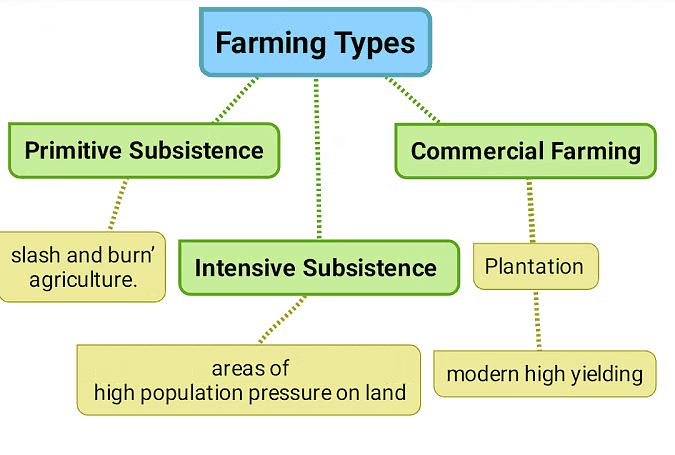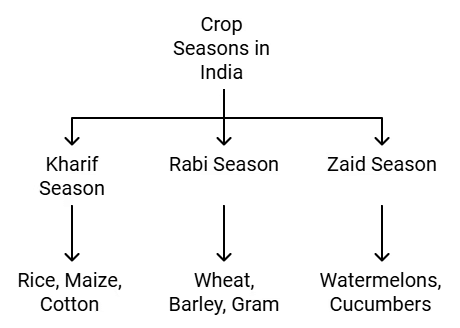Class 10 Exam > Class 10 Notes > Social Studies (SST) Class 10 > Key Concepts: Agriculture
Key Concepts: Agriculture | Social Studies (SST) Class 10 PDF Download
- Agriculture in India includes land cultivation, animal husbandry, and fishing.
- Types of farming: Primitive subsistence farming, intensive subsistence farming, and commercial farming.
- Primitive subsistence farming involves small, scattered landholdings, primitive tools, and no use of fertilisers or high-yielding seeds.

- Intensive subsistence farming is practiced in areas with high population pressure, using irrigation, fertilisers, pesticides, and machines.
- Commercial farming uses modern inputs to increase productivity, and plantation farming involves growing a single crop over a large area.
- India has three crop seasons: Kharif (June-October), Rabi (October-April), and Zaid (between Rabi and Kharif).
- Kharif crops include rice, maize, millet, cotton, and groundnut.
- Rabi crops include wheat, barley, and oilseeds.
- Zaid crops include watermelon, cucumber, and vegetables.
- India grows a variety of crops: cereals, pulses, oilseeds, fiber crops, beverage crops, and cash crops.
- Cereals cover about three-fourths of the cropped area, including rice, wheat, maize, millet, and pulses.

- Fiber crops like cotton and jute are important, while tea and coffee are major beverage crops.
- Cash crops include sugarcane, rubber, tobacco, and spices.
- Oilseeds like groundnut, mustard, and sunflower are grown for oil extraction, and used in cooking and industry.
- Technological advancements include the replacement of the Persian wheel with water pumps, ploughs with tractors, and bullock carts with trucks.
- Drip irrigation is replacing field flooding, and chemical fertilisers are being replaced by bio-fertilizers.
- The Green Revolution and Operation Flood increased crop yields and milk production.
- The government abolished the Zamindari system.
- Radio and television help educate farmers on new techniques.
- Crop rotation improves soil health and reduces pest buildup.
- Sericulture involves rearing silkworms for silk production, an important cottage industry.
- Jhum cultivation is practiced in Northeastern India, involving slash-and-burn agriculture.
The document Key Concepts: Agriculture | Social Studies (SST) Class 10 is a part of the Class 10 Course Social Studies (SST) Class 10.
All you need of Class 10 at this link: Class 10
|
66 videos|614 docs|79 tests
|
FAQs on Key Concepts: Agriculture - Social Studies (SST) Class 10
| 1. What are the main types of agriculture? |  |
Ans. The main types of agriculture include subsistence agriculture, commercial agriculture, industrial agriculture, and organic agriculture. Subsistence agriculture focuses on growing enough food for the farmer and their family, while commercial agriculture aims at producing crops for sale in the market. Industrial agriculture involves large-scale farming operations that often use advanced technologies, and organic agriculture emphasizes the use of natural processes and materials without synthetic pesticides or fertilizers.
| 2. How does climate change affect agriculture? |  |
Ans. Climate change affects agriculture in several ways, including altered rainfall patterns, increased temperatures, and more frequent extreme weather events. These changes can lead to reduced crop yields, increased pest and disease pressures, and challenges in water availability. Farmers may need to adapt their practices, such as changing planting dates or adopting drought-resistant crop varieties, to cope with these impacts.
| 3. What are the benefits of sustainable agriculture? |  |
Ans. Sustainable agriculture offers numerous benefits, including improved soil health, enhanced biodiversity, and reduced environmental impact. It promotes practices that conserve water and energy, reduce chemical inputs, and support local ecosystems. Sustainable agriculture also aims to provide fair wages for farmers and ensure food security for communities, making it a holistic approach to food production.
| 4. What role does technology play in modern agriculture? |  |
Ans. Technology plays a significant role in modern agriculture by improving efficiency and productivity. Innovations such as precision farming, drones, and automated machinery help farmers optimize their operations. Additionally, data analytics and smart farming techniques allow for better decision-making regarding crop management, resource allocation, and yield prediction, ultimately leading to more sustainable agricultural practices.
| 5. Why is crop rotation important in agriculture? |  |
Ans. Crop rotation is important in agriculture as it helps maintain soil fertility and reduce the risk of pests and diseases. By alternating the types of crops grown in a particular field, farmers can prevent nutrient depletion and improve soil health. This practice also disrupts the life cycles of pests and pathogens, leading to healthier crops and potentially reducing the need for chemical inputs.
Related Searches






















